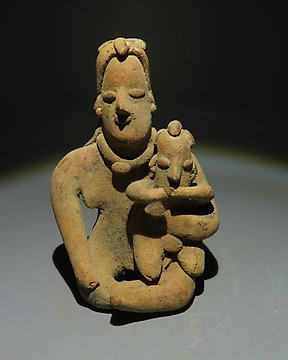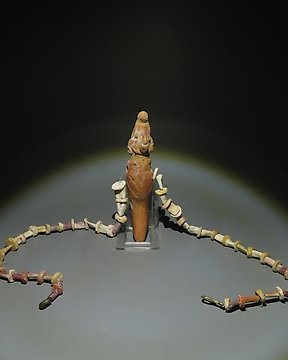Magnífica la entrega y el objeto. Perfecta la sonido del sibato
Übersetzung ansehenColima, Westmexiko Terracotta Figur. 200 v. Chr. – 500 n. Chr. 14,2 cm H. Spanische Importlizenz.
Nr. 88191479
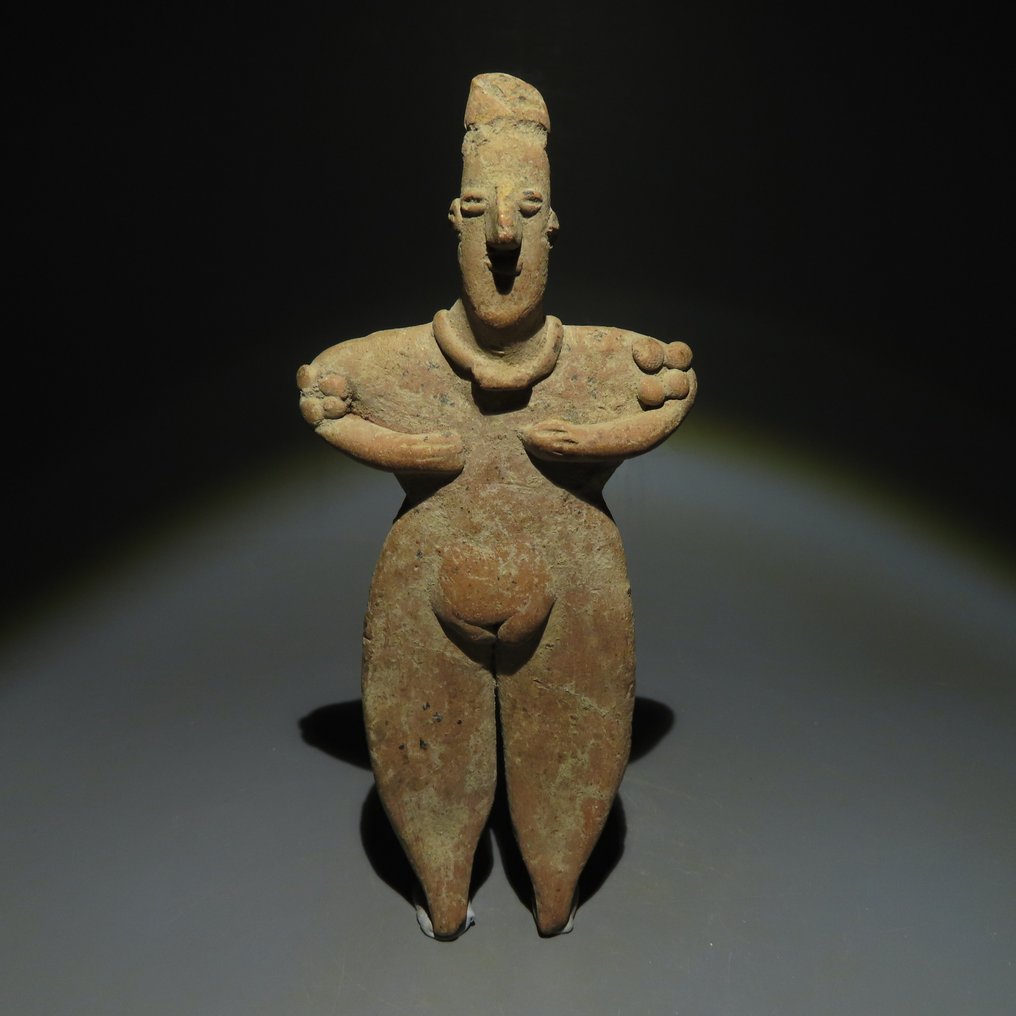
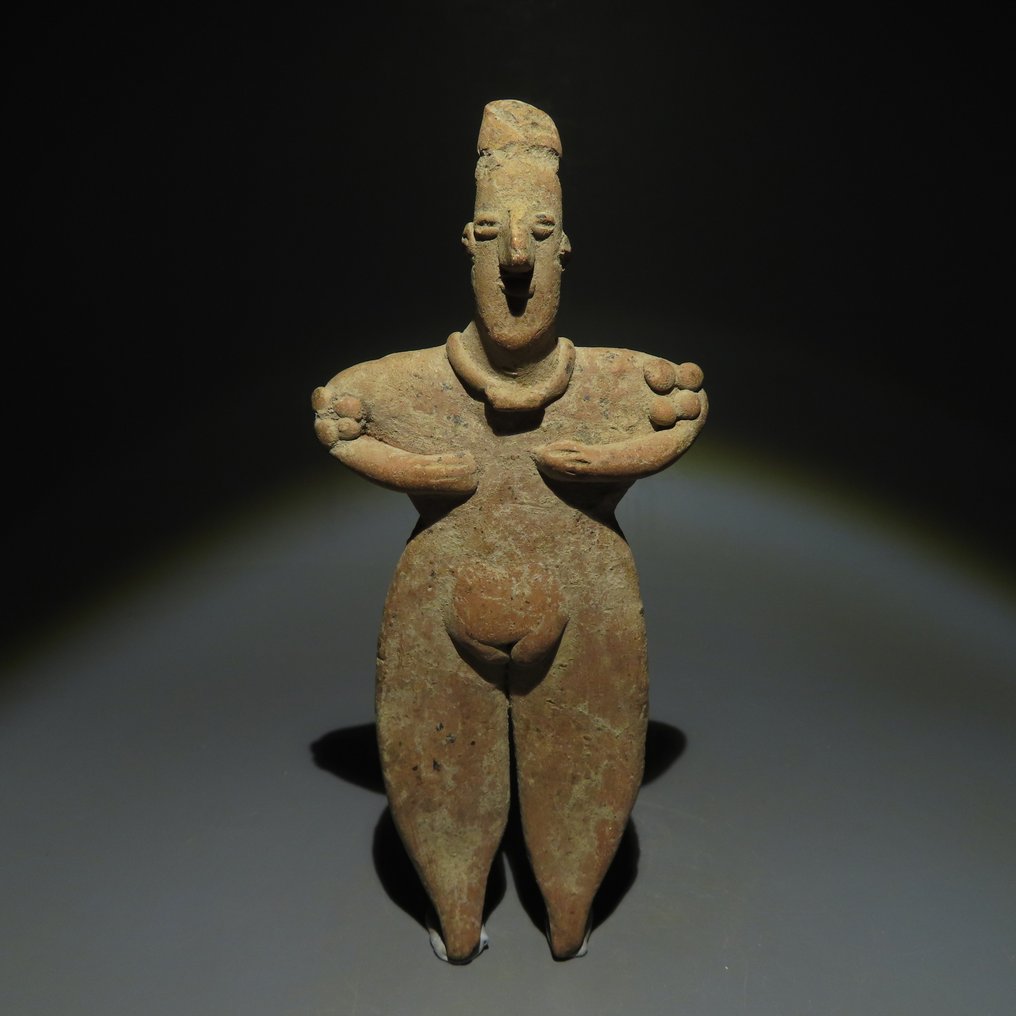
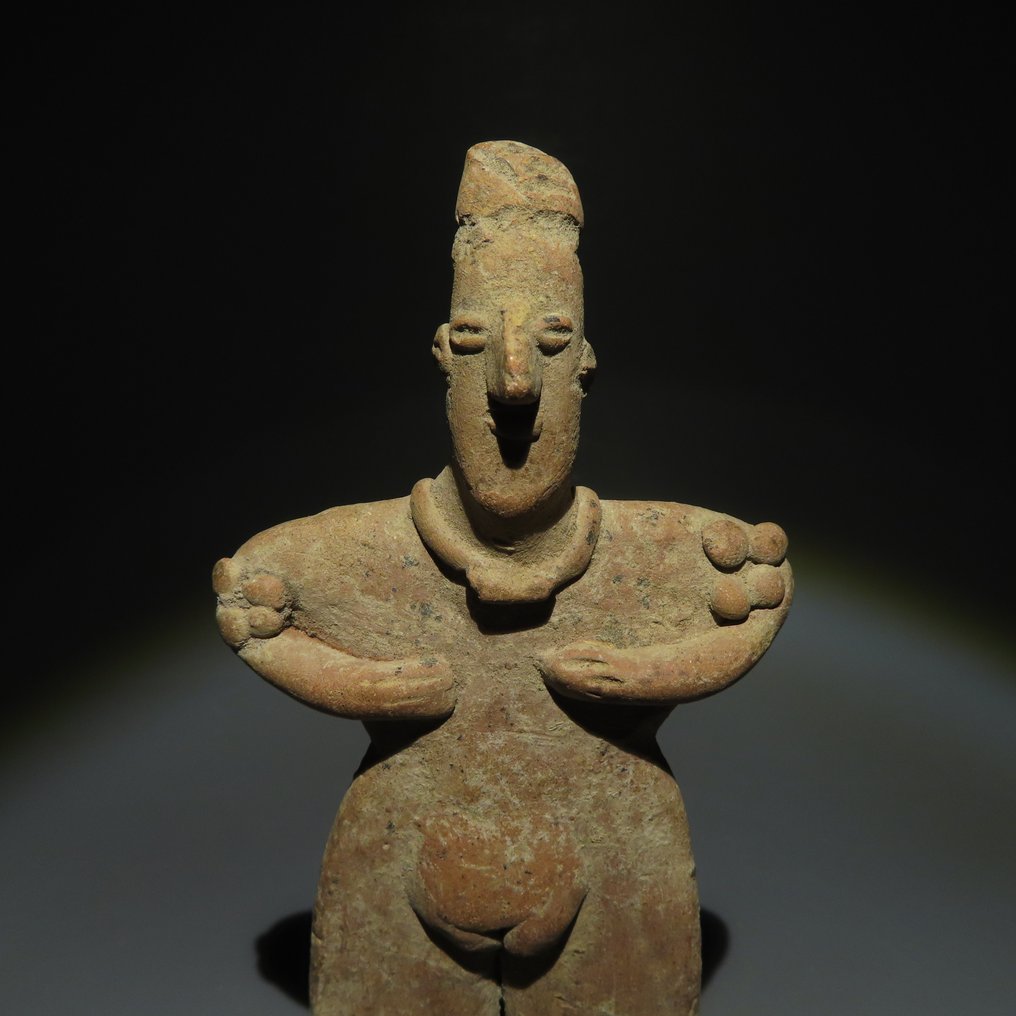
Figure
CULTURE: Colima, Western Mexico
PERIOD: 200 BC - 500 AD
MATERIAL: Terracotta
DIMENSIONS: 14.2 cm H.
PROVENANCE: Private collection, West Olive, United States of America.
CONDITION: Good condition.
DESCRIPTION:
The Colima people lived in northwest Mexico, in a rugged, low-lying coastal region carved by valleys, each with its own ecology and a warm, humid climate.
Little is known about their modes of subsistence, as most of the information we have comes from artifacts from private collections and from the excavation of cemeteries, not residential sites, which usually provide this kind of information. We do know that they practiced irrigation farming, which allowed them to live in large groups in relatively independent villages and urban centers.
Colima ceramics display a wide variety of figures and shapes, but little variation in technique. Most pieces have a burnished red finish and some are decorated with orange or white incisions. Molded figures are common, especially of plants, animals (especially dogs) and seashells. Human representations typically feature dwarfs and hunchbacks more than others, and few female forms. Many of these figures have “coffee-bean” eyes and are dressed in finely detailed traditional attire. Little is known of Colima stonework; only a few pieces such as mace heads, small masks and figurines have been found. These people also practiced basketweaving and weaving, and used metallurgy to make objects such as needles, axes, rattles, nose rings and ear ornaments.
Little is known about the Colima’s social order, but shamans or priests may have occupied positions of social importance. The existence of figurines resembling warriors as well as prisoners with hands tied points to the ceremonial importance of war in this pre-Columbian society.
The vast majority of ceramic pieces that have been ascribed to this culture are grave goods found in the tombs of individuals of high social rank. The Colima buried their dead in family tombs up to 30 meters deep, some with multiple chambers. The bodies were accompanied by a wide variety of grave goods, including ceramic statuettes of armed men, which served as symbolic guardians. Ceramic sculptures of dogs were another common grave good, and were believed to be the emissaries of Xolotl, the god of death.
The history of the Colima people is not well known, but, like many Mesoamerican cultures, the Colima displayed some stylistic elements that links them with the ancient Olmecs.
Notes:
- The piece includes authenticity certificate.
- The piece includes Spanish Export License.
- The seller guarantees that he acquired this piece according to all national and international laws related to the ownership of cultural property. Provenance statement seen by Catawiki.
Der Verkäufer stellt sich vor
Figure
CULTURE: Colima, Western Mexico
PERIOD: 200 BC - 500 AD
MATERIAL: Terracotta
DIMENSIONS: 14.2 cm H.
PROVENANCE: Private collection, West Olive, United States of America.
CONDITION: Good condition.
DESCRIPTION:
The Colima people lived in northwest Mexico, in a rugged, low-lying coastal region carved by valleys, each with its own ecology and a warm, humid climate.
Little is known about their modes of subsistence, as most of the information we have comes from artifacts from private collections and from the excavation of cemeteries, not residential sites, which usually provide this kind of information. We do know that they practiced irrigation farming, which allowed them to live in large groups in relatively independent villages and urban centers.
Colima ceramics display a wide variety of figures and shapes, but little variation in technique. Most pieces have a burnished red finish and some are decorated with orange or white incisions. Molded figures are common, especially of plants, animals (especially dogs) and seashells. Human representations typically feature dwarfs and hunchbacks more than others, and few female forms. Many of these figures have “coffee-bean” eyes and are dressed in finely detailed traditional attire. Little is known of Colima stonework; only a few pieces such as mace heads, small masks and figurines have been found. These people also practiced basketweaving and weaving, and used metallurgy to make objects such as needles, axes, rattles, nose rings and ear ornaments.
Little is known about the Colima’s social order, but shamans or priests may have occupied positions of social importance. The existence of figurines resembling warriors as well as prisoners with hands tied points to the ceremonial importance of war in this pre-Columbian society.
The vast majority of ceramic pieces that have been ascribed to this culture are grave goods found in the tombs of individuals of high social rank. The Colima buried their dead in family tombs up to 30 meters deep, some with multiple chambers. The bodies were accompanied by a wide variety of grave goods, including ceramic statuettes of armed men, which served as symbolic guardians. Ceramic sculptures of dogs were another common grave good, and were believed to be the emissaries of Xolotl, the god of death.
The history of the Colima people is not well known, but, like many Mesoamerican cultures, the Colima displayed some stylistic elements that links them with the ancient Olmecs.
Notes:
- The piece includes authenticity certificate.
- The piece includes Spanish Export License.
- The seller guarantees that he acquired this piece according to all national and international laws related to the ownership of cultural property. Provenance statement seen by Catawiki.
Der Verkäufer stellt sich vor
- 818
- 10
- 1
very well packed with all the documents included, thnks
Übersetzung ansehenGreat object. Really beautiful. Quick delivery. Excellent.
Übersetzung ansehenSuperbe objet, Service d'Arqueologia Ancient Art excellent et rapide. Jaume Bagot toujours parfait .
Übersetzung ansehenTodo perfecto gracias
Übersetzung ansehenNice item all ok A+++
Übersetzung ansehenThank you for this Oinochoe, one question: did you as promised read my post!
Übersetzung ansehenVery cooperative in every aspect of the transaction.
Übersetzung ansehenAlways a great pleasure!
Übersetzung ansehenFine quality, good service. Thanks.
Übersetzung ansehenMuy amables, muy bien todo. Gracias
Übersetzung ansehenAlles bestens
Übersetzung ansehenexactly as described and shipped safely and punctually.
Übersetzung ansehenschnelle Lieferung sehr sichere Verpackung alles bestens
Übersetzung ansehentres bel objet je le recherchai depuis longtemps envoi rapide et protégé je pense qu'il y aura d'autres achats avec ce vendeur merci +++++++
Übersetzung ansehenEinfach nur toll
Übersetzung ansehenTodo perfecto
Übersetzung ansehenottimo
Übersetzung ansehenperfetto
Übersetzung ansehentop oggetto bellissimo grazie 💯💯💯💯💯💯 :-)
Übersetzung ansehenI bought this beautiful artifact together with artifact from Mr. Bagot but although it is clearly stated on his shipping page that when purchasing multiple artifacts i paid the double package costs
Übersetzung ansehenI bought this beautiful artifact together with artifact from Mr. Bagot but although it is clearly stated on his shipping page that when purchasing multiple artifacts i paid the double package costs
Übersetzung ansehenBel objet, bien emballé. Parfait.
Übersetzung ansehenwonderful faiece and very fast shipping.thanks a lot
Übersetzung ansehenJ Bagot es un profesional excelente. Sus artículos son de gran calidad, se incluye la documentación necesaria y el embalaje se realiza con esmero. Le recomiendo encarecidamente.
Übersetzung ansehen- 818
- 10
- 1
Magnífica la entrega y el objeto. Perfecta la sonido del sibato
Übersetzung ansehenDisclaimer
Der Verkäufer garantiert und kann belegen, dass das Objekt legal erworben wurde. Der Verkäufer wurde von Catawiki darüber informiert, dass er die Unterlagen, die gemäß den Gesetzen und Vorschriften seines Landes erforderlich sind, zur Verfügung stellen muss. Der Verkäufer garantiert, dass er berechtigt ist, das Objekt zu verkaufen/auszuführen. Der Verkäufer wird dem Käufer alle Informationen, die zur Provenienz des Objekts vorliegen, zur Verfügung stellen. Der Verkäufer versichert, dass alle erforderlichen Genehmigungen eingeholt wurden/werden. Der Verkäufer wird den Käufer unverzüglich über etwaige Verzögerungen bei der Einholung dieser Genehmigungen informieren.
Der Verkäufer garantiert und kann belegen, dass das Objekt legal erworben wurde. Der Verkäufer wurde von Catawiki darüber informiert, dass er die Unterlagen, die gemäß den Gesetzen und Vorschriften seines Landes erforderlich sind, zur Verfügung stellen muss. Der Verkäufer garantiert, dass er berechtigt ist, das Objekt zu verkaufen/auszuführen. Der Verkäufer wird dem Käufer alle Informationen, die zur Provenienz des Objekts vorliegen, zur Verfügung stellen. Der Verkäufer versichert, dass alle erforderlichen Genehmigungen eingeholt wurden/werden. Der Verkäufer wird den Käufer unverzüglich über etwaige Verzögerungen bei der Einholung dieser Genehmigungen informieren.
